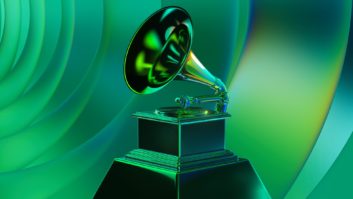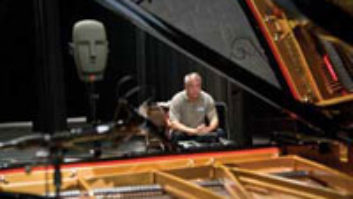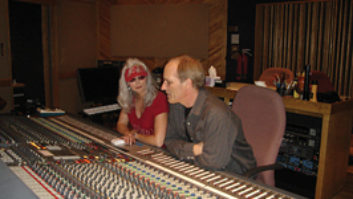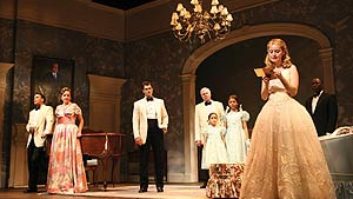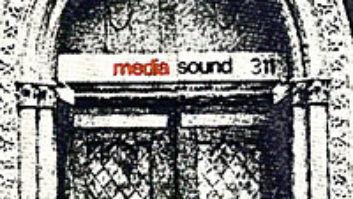Steve Epstein
photo: Nick Bastion
Steve Epstein has snared 13 Grammy Awards in a 30-plus-year career that has brought him into professional contact with many of the greatest musicians of his time, including Isaac Stern, the Juilliard Quartet, Yo-Yo Ma, Rudolf Serkin, Chick Corea, Wynton Marsalis, Midori and many others. You might think that he would be ready to downshift — but you’d be wrong. The longtime Sony/BMG/Masterworks producer is maintaining his relationship with that label while pursuing a variety of independent projects. He’s also staying in touch with his early love of technology and broadening his skill set to include digital editing at his home project studio. And in 2005, he was on the short list yet again for Producer of the Year, Classical: his 27th Grammy nomination. (At press time, the awards were a few weeks away.)
In the early to mid-1960s, when many of his contemporaries were listening to masterpieces such as The Troggs’ “Wild Thing” and The Cyrkle’s “Red Rubber Ball,” Epstein was studying the covers of classical recordings and building short-wave radios from Heathkit catalogs. “I used to imagine I was sitting in the concert hall while I listened to these records,” says Epstein. “I studied the credits and kept coming across the names of these great producers, including Tom Frost and Tom Sheperd — who ran Columbia Masterworks together from the late ’60s through the mid-’70s — and Andy Kazdin.”
Although the former Queens, N.Y., resident says that he was a “barely proficient” violinist, Epstein gained first-hand awareness of orchestral textures when he landed positions with the New York All-City High School Orchestra and eventually his college orchestra; hearing great music unfold from the inside would have a significant impact on the miking techniques he later developed. Before heading off to Hofstra University, Epstein pestered Frost with letters and requests, which ultimately paid off with an invitation to come in and chat. “Tom was great to me,” Epstein recalls. “Back then, there weren’t any programs in recording technology. He told me I should major in music with a possible minor in communications, which I did at Hofstra. I also worked at their excellent radio station as classical music director and engineer for all four years.”
Using school microphones and eventually a Revox 77 tape recorder, which he purchased for about $600 during his senior year, Epstein sought out chamber groups to record. All the while, the college kid was working on a plan. “Every step of the way,” he says, “I was preparing myself to march right back to Tom Frost and ask for a job.
Steve Epstein (standing) with Yo-Yo Ma (center) and members of the Silk Road Ensemble during sessions at the now-defunct Hit Factory (New York City)
“That time — the early 1970s — was really, I believe, the tail end of the golden age of recording. A few major companies still had some of the great orchestras under contract, and labels had reputations based on the artists they kept in their stables. Columbia had the New York Philharmonic and the Cleveland Orchestras, as well as Horowitz and Bernstein; it was all very exciting. My initial interview at Columbia was with Tom Frost and Tom Sheperd, and I was nervous; maybe even more so when I was called back for a second interview in June of that year, 1973. I knew they had one job to offer and another applicant with more experience than me. But I got a call in September saying they’d decided to hire both of us, and I went to work immediately.
“In those days, there was a clear distinction between engineers and producers, and the union had a hand in keeping their tasks separate. As a producer — or music editor back then — I wasn’t allowed to touch Columbia’s in-house equipment. Buddy Graham, the legendary engineer with whom I was fortunate to work with until his retirement in 1991, told me that he was working with Leopold Stokowski one day and Stokowski really wanted to get involved with the mix. But he wasn’t allowed to touch the board either, and so he put his hands on Buddy’s and guided the moves! Buddy told me that they even breathed in unison!”
The importance of mic placement became clear to Epstein very early in his career. “The first disc I made for CBS was a recording of Mozart’s last four quartets with the Juilliard Quartet, a group I idolized as a student. We recorded at Columbia’s 30th Street Studios, one of the greatest studios in the country. It was originally built in 1857 as a church. In 1981, someone at CBS Records made the moronic decision to sell the real estate and it was torn down to make a high-rise. I believe the final recording at this location was Glenn Gould’s last version of Bach: The Goldberg Variations — one of the early digital recordings.
“Buddy was the engineer on the Juilliard session. Back then, the general practice was to have four closely placed cardioid mics mixed with ambience mics on the same four tracks of a multitrack. You can imagine the potential phasing problems! But playback equipment wasn’t as sensitive as it is today, and the recordings were EQ’d to sound effective.”
Epstein would use orchestral sessions to experiment with mic setups, and eventually he moved away from having up to 17 or 18 AKG C 12s hovering over the orchestra. “We went all the way down to tracking with only two microphones, which, whenever possible, is how I work today,” Epstein says. “This puts more pressure where it belongs — on the conductor and players! If an oboe solo needs to be louder, I’d rather do another take and have the player push the extra air required to achieve the proper balance. Making him/her achieve the right level adds upper harmonics and a natural, organic sound. Of course, to successfully use two microphones, you need the right environment, as well as excellent players and a conductor who can achieve the proper balances. In an orchestral session, we will always be sure to cover the ensemble with as many spot mics as we feel are necessary should we need to refine a balance. Considering the large investment labels make in symphonic recordings, it would be way too chancy not having this option. If we don’t need them, we don’t use them.
“But I’m getting ahead of myself. We started out with all these microphones. As time went on, I began using three AKG 414s in cardioid as a basic pickup for the orchestra. We’d use Neumann KM84s for string spots until we found ourselves up in Canada working with the Toronto Symphony in 1980. Buddy and I weren’t happy with the sound we were getting, and so we decided to change our strategy. We’d never used omnis for our main pickups, but we switched the 414s from cardioid to omni; we needed to open things up, to get some more air, and we liked the sound. It may seem trivial, but this was the beginning of a shift in how we approached making records.
“Then we started using three Schoeps omnis — MK2 capsules — either in a Tree configuration or as a spaced set, and ultimately we pared that technique down even further. One day, a design engineer from B&K [now DPA] came into my office and showed me their new mic, the 4003. The 4003 and the 4009, the 4003’s descendant, have become my microphones of choice ever since, although, depending on a variety of factors, we also continue to use Schoeps omnis as an overall pickup.
“One of the first recordings we made using just a pair of microphones was a session with Lorin Maazel and the Pittsburgh Symphony in Heinz Hall where we used the 4009s. Union rules prohibited us from rolling tape during rehearsals, but we could set up and balance microphones, which we did prior to those dates. We were tracking some huge material, including the [Camille] Saint-Saëns Organ Symphony and [Ottorino] Respighi’s The Pines of Rome. After some work positioning and repositioning our main mics, we discovered that, lo and behold, we could get an accurate sound with only those two mics. By eliminating many microphones in the signal chain, we were able to reduce distortion as we were capturing greater depth, dynamic range and imaging. Another advantage is an increase in the signal-to-noise ratio. The question of presence in a recording and conveying the ambience of the space is another important consideration, particularly when you’re planning on releasing a title in surround sound. I consider the room, in effect, as another instrument.”
After 33 uninterrupted years as an employee of the company now known as Sony/BMG/Masterworks, Epstein is embarking on the next leg of his professional journey. Although he has a host of projects lined up for them — including the complete violin/piano sonatas of Brahms, featuring Nikoaj Znaider and Yefim Bronfman, and Midori’s take on a set of Mozart sonatas — Epstein has also hung out a shingle advertising his services as a freelance producer. He produced the cast recording of Adam Guettel’s multiple Tony Award — winning score to the musical The Light in the Piazza, which was tracked and mixed by Todd Whitelock for Nonesuch Records. This has led to a series of projects that Epstein will produce for that label. “I really enjoyed working on that absolutely gorgeous score,” says Epstein. “I’ve been fortunate to work with some great engineers, and Todd is in that line. We mixed in Room 309 at Sony Music Studios. The signal path includes Meitner converters and an analog board that Sony Music Studios custom-built and which is incredibly musical.”
Epstein in Right Track’s (New York City) Studio A509 during a session for Mark O’Connor’s group, Hot Swing
To maintain the flexibility that will allow him to work on the projects that interest him, rather than just those that command the highest fee, Epstein has put a Sequoia system into his project studio. This move has brought him full circle, back to the days when he spent hours tinkering over gear in his parents’ living room. “Editing is great therapy, like kit-building!” he says. “I’ve tinkered with different editing systems. Back in 1982 or so, I had the luxury of sitting in a London editing suite working with a Sony DAE 1100. We had just finished recording Michael Tilson Thomas and the Philharmonica’s performance of Tchaikowsky’s Orchestral Suites 2 and 4 at Abbey Road. The DAE 1100 was Sony’s first really good digital editor. It worked with the 1630 digital electronics with a pair of Umatic tape machines. It wasn’t computer editing, but it was satisfying, and I was able to get hands-on experience.
“In the course of time, as computer editing systems evolved, I had the opportunity to observe editing sessions, but I never owned a system of my own. When I started thinking about putting an editing station into my place, I contacted Tom Sailor of Synthax, the company that distributes Sequoia in the U.S. Lots of engineers I respect had positive things to say about Sequoia, and I wanted to check it out. Sequoia has outstanding sound quality, and its crossfade editor, in my experience, is second to none. I’ve played around with the plug-in effects and am very impressed, but I haven’t used them yet on any projects. If I go deeper into production, I’ll use them.”
Epstein and Richard King, his engineer and longtime collaborator, recently recorded the violinist Cho-Liang Lin and the Sejong Players for a Naxos release at the Church of the Holy Trinity on Manhattan’s upper east side. “The church has very good acoustics,” Epstein says. “We recorded the group’s performance of The Four Seasons and two other Vivaldi concertos. Richard tracked onto a Pyramix system, which he copied onto my hard drives. I’ll make the edits on multitrack files and take them back to Sony Music Studios — probably Room 309 again — for mixing. It’s a great way to work!
Gary Eskow is a contributing writer to Mix.
SELECTED DISCOGRAPHY
P=producer, ME=music editor, AC=audio consultant, RD=recording director, M=mastering, E=engineer, MX=mixing
Acoustic Christmas Various Artists (P, 1990)
Brass Super Hits Various Artists (P, 2004)
Carnegie Hall Christmas Concert Various Artists (AC, 1991)
Christmas All Over the World Various Artists (P, 2002)
Christmas of Hope Various Artists (P, 1995)
Classic Gershwin Various Artists (P, 1987)
Columbia Jazz Fall 1987 Sampler Various Artists (P, 1987)
Richard Condie: Great “Messiah” Choruses (ME, 1973)
Crouching Tiger, Hidden Dragon soundtrack (P, 2000)
Stephen Foster:Beautiful Dreamer: The Songs of Stephen Foster (P, 2004)
Gary Lawrence & His Sizzling Syncopators:Gary Lawrence & His Sizzling Syncopators (P, 2005)
Gershwin on BroadwayVarious Artists (P, 1976)
Adam Guettel:Light in the Piazza (P/M, 2005)
Jazz at Lincoln Center Presents: The Fire of the Fund Various Artists (RD, 1991)
Jazz: The Definitive Performances Various Artists (P, 1999)
Jazzy Wonderland Various Artists (P, 1990)
Billy Joel:Fantasies & Delusions (P/M, 2001), My Lives (P, 2005)
Marlon Jordan:For You Only (P, 1988)
KDFC: Islands of Sanity Various Artists (P, 2002)
Phoebe Legere: Last Tango in Bubbleland (trumpet, 1997)
Edwin London:Jove’s Nectar (E, 2001)
Yo-Yo Ma: Hush with Bobby McFerrin (P, 1992), Lulie the Iceberg (P, 1999), Solo (P, 1999), Appalachian Journey (P, 2000), Silk Road Journeys: When Strangers Meet With The Silk Road Ensemble (P, 2002), Obrigado Brazil (P, 2003), Obrigado Brazil Live in Concert (P/M, 2004), Silk Road Journeys: Beyond the Horizon With The Silk Road Ensemble (P, 2004), Sounds of Yo-Yo Ma (P, 2004)
Wynton Marsalis: English Chamber Orchestra (P, 1984), Hot House Flowers (P, 1984), Black Codes (From the Underground) (P, 1985), Live at Blues Alley with quartet (P, 1986), Marsalis Standard Time, Vol. 1 (P, 1986), Standard Time, Vol. 2: Intimacy Calling (P, 1987), Levee Low Moan: Soul Gestures in Southern Blue, Vol. 3 (P, 1988), Majesty of the Blues (P, 1988), Thick in the South: Soul Gestures in Southern Blue, Vol. 1 (P, 1988), Uptown Ruler: Soul Gestures in Southern Blue, Vol. 2 (P, 1988), Crescent City Christmas Card (P, 1989, Tune in Tomorrow soundtrack (P, 1989), Blue Interlude Wynton Marsalis Septet (P, 1991), In This House, On This Morning (P, 1992), Classic Wynton (P, 1998), Standard Time, Vol. 5: The Midnight Blues (P, 1998), Fiddler’s Tale (P, 1999), Live at the Village Vanguard (P, 1999), Standard Time, Vol. 6: Mr. Jelly Lord (P, 1999), London Concert: Haydn/Hummel/Mozart/Fasch (P, 2000), All Rise (P, 2002), Trios (P, 2004), Unforgivable Blackness: The Rise and Fall of Jack Johnson (P, 2004)
Brian Melvin:Night Food (P, 1984)
Paul Mousavi:Sound Mind (P, 1994)
Orchestra of St. Luke’s:Listen to the Storyteller: A Trio of Musical Tales From Around the World (P, 1999)
2005 Our New Orleans: A Benefit Album for the Gulf Coast Various Artists (P/MX, 2005)
Rosa Passos:Amorosa (P, 2004)
Mandy Patinkin: Mandy Patinkin (P, 1989), Dress Casual (P, 1990)
Murray Perahia: Plays Brahms (P, 1991)
Marcus Roberts:Portraits in Blue (P, 1995)
David Sanchez:Coral (P, 2004)
Swing [Original Broadway Cast] Original Broadway Cast (P, 2000)
Michael Tilson Thomas:Of Thee I Sing/Let ‘Em Eat Cake (P, 1987)
Today’s Top Hits, Vol. 11 Various Artists (P, 1955)
Ronan Tynan:My Life Belongs to You (P, 2002)
Ultimate Classical Christmas Album of All Time Various Artists (P, 2002)
X Dot Jazz Sampler, Vol. 1 Various Artists (P, 1996)
On winning a Grammy Award at the 43rd Annual Grammy Awards (2001) for Producer of the Year, Classical:
A seven-time Grammy winner (including Producer of the Year in ’84, ’95, ’97 and ’98), Epstein didn’t attend this year’s festivities. “I was up against some very strong competition, some wonderful producers, and, quite frankly, I wasn’t so sure it was going to be a winning year for me,” he says. “Honestly, it’s always a surprise to me, and a happy one.” Epstein notes that he was nominated “for a more eclectic group of recordings this year than usual,” which may have helped him.
Two were high-profile “crossover” projects: Appalachian Journey featured a diverse group of classical, pop and country players that included Yo-Yo Ma, Edgar Meyer, Mark O’Conner, James Taylor and Alison Krauss. It was recorded in Mechanics Hall in Worcester, Mass. (“My favorite venue for recording chamber music,” Epstein says.), using only a pair of B&K 4009 mics to DSD. Chick Corea’s Corea.Concerto brought together the jazz pianist’s regular sextet and a symphony orchestra at Air Studios in London.“The challenge there,” Epstein says, “was to combine two different approaches to recording: For the jazz group, you want to be in close, to capture the power of the individual instruments, whereas with the orchestra, you’re going for a more natural overall sound of the ensemble. The trick is to get the best of both elements.”
Other discs Epstein was honored for were Corigliano: Phantasmagoria, a collection of Dvorák pieces, and pianist Murray Perahia’s Song Without Words.
On producing Leonard Bernstein’s West Side Story Suite, which garnered a Best Engineering Album, Classical at the 44th Annual Grammy Awards (2002):
London Philharmonic Orchestra, Joshua Bell (violin). Engineered by Richard King. Produced by Steven Epstein.
Three-time Best Engineered Album nominee Richard King admits that he was nervous at the Staples Center, “but fortunately, they give out the engineering awards first, so then I could relax and enjoy the show. I’m still in shock that I actually won.”
The CD was cut over the course of four three-hour sessions at AIR Lyndhurst in London. “I like that room a lot,” King says. “It has a sort of close, direct sound because the floor space isn’t very large, but combined with the high ceiling and the balcony, it has great natural reverb. It takes a little work, and it can be a bit quirky, but it sounds really nice.” Typical of classical work, the orchestra played each piece several times, then there were various small sections that were re-done, before it was edited and mixed at Sony Studios in New York, King’s home base.
King was actually a double-winner on Grammy night: In addition to his victory in this category, he and producer Steven Epstein were given trophies for their work on the Best Soundtrack Album winner, Crouching Tiger, Hidden Dragon, which was recorded in Shanghai.
The King-Epstein team is currently working on an exotic project with cellist Yo-Yo Ma, recording music from and inspired by the ancient trade route known as the “Silk Road,” which stretched from Japan to Italy hundreds of years ago.
